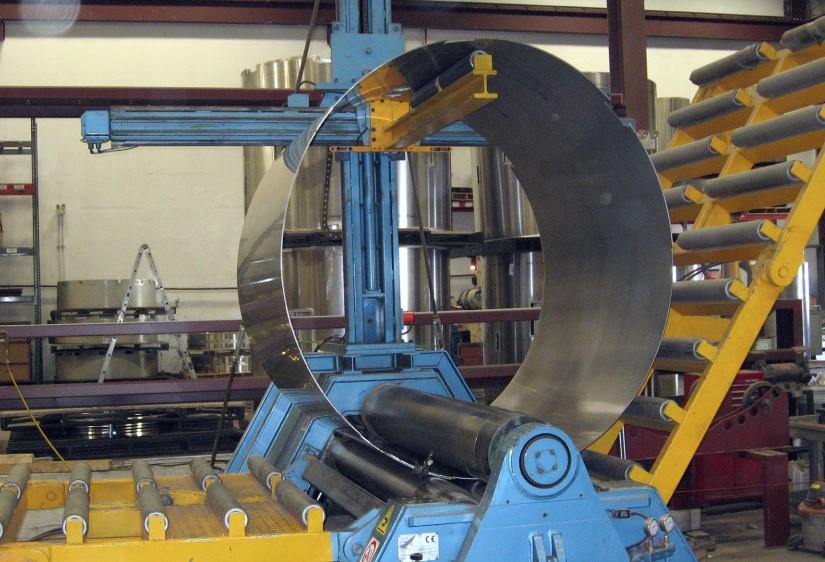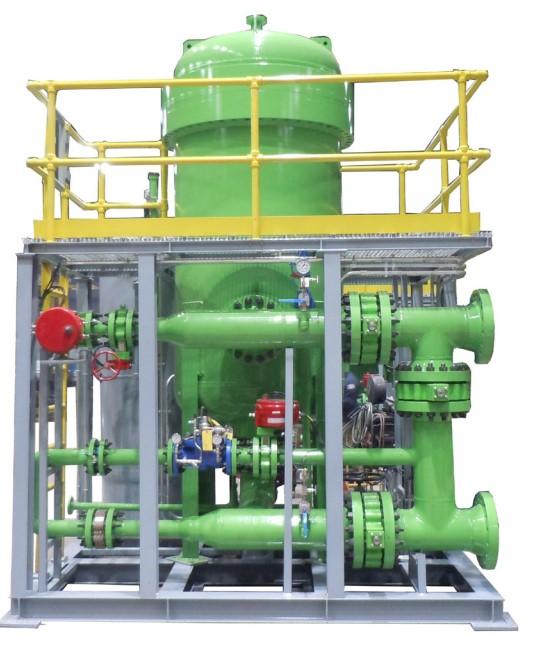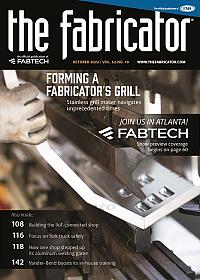Senior Editor
- FMA
- The Fabricator
- FABTECH
- Canadian Metalworking
Categories
- Additive Manufacturing
- Aluminum Welding
- Arc Welding
- Assembly and Joining
- Automation and Robotics
- Bending and Forming
- Consumables
- Cutting and Weld Prep
- Electric Vehicles
- En Español
- Finishing
- Hydroforming
- Laser Cutting
- Laser Welding
- Machining
- Manufacturing Software
- Materials Handling
- Metals/Materials
- Oxyfuel Cutting
- Plasma Cutting
- Power Tools
- Punching and Other Holemaking
- Roll Forming
- Safety
- Sawing
- Shearing
- Shop Management
- Testing and Measuring
- Tube and Pipe Fabrication
- Tube and Pipe Production
- Waterjet Cutting
Industry Directory
Webcasts
Podcasts
FAB 40
Advertise
Subscribe
Account Login
Search
A shift towards engineering technologies evolve Boston-area heavy fabricator
The New England fabricator not just a built-to-print operation anymore
- By Tim Heston
- October 19, 2022
- Article
- Shop Management

BEPeterson’s precision rolling capabilities have helped it gain a significant foothold in the medical market.
Most think of manufacturing as an industry of technological advancement. In metal fabrication, the machines on the floor play a role in determining the type of work the operation tackles. Still, one could argue that the greatest changes come not from technology on the floor but from the interaction with its customers.
An operation that builds products to print can be very different from an operation that develops engineering partnerships with clients. Most fabricators operate somewhere on a kind of engineering-services spectrum. Some offer basic design-for-manufacturability while others collaborate with customers early in the design process to become an engineering partner.
For the past 15 years, Avon, Mass.-based BEPeterson has moved toward the latter, a shift that has become foundational to its future growth. The strategy has repositioned the company to tackle new markets and new kinds of fabrication. In short, the 80-employee operation has come a long way from where it was 15 years ago, when just one customer represented 75% of its entire business.
From Coal Nozzle Tips to Fuel Cells
BEPeterson launched as a small job shop in 1935. By 1974, the shop had begun working with Alstom, a utility equipment maker, to produce nozzle tips used in coal-fired boilers in power plants. It perfected the fabrication of these nozzles and even developed a way to automate the laborious hardfacing process. The place wasn’t a small job shop anymore.
Of course, the coal-fired power plant business isn’t what it was. “That business has declined. We had a recent bounce-back [this year], but prior to that, the business had been steadily going down.”
That was CEO Terry Moore, who has led the company since 2005. “When I got to the reigns of BEP, I knew of its proud heritage since 1935. But we also knew things had to change. We never lost sight of that, and now we’re identifying the right vehicle to take us there.”
By the late 2000s, in its quest to diversify the customer base, the company began to see serious upgrades to its forming and fabrication capabilities. A precision four-roll system from Faccin, complete with side and overhead supports, formed 3/16-in. stainless steel cylinders up to 70 in. diameter, within a tolerance of ±1/32 in. on the circumference. This and other technologies moved the company into new markets, including medical equipment. Those precision-rolled stainless cylinders, for instance, were destined for MRI machines. Such work has been key to BEPeterson’s revenue diversification.
“We now use the [initialism] BEP, building engineering partnerships,” said Dan Szczurko, vice president of business development. “We’ve focused heavily on resources in engineering and quality control to help customers through the design phase of projects and working on more complicated programs. We’re now not just working on vessels; we’re working on full system integration, including pumps, values, actuators, and tying it all together with programmable logic control. We’ve gained a lot of traction in the defense industry, providing different types of vessels and test systems. And we’ve done additional work in the medical industry outside the MRI business.”
For instance, one relatively new customer produces equipment used in boron neutron capture therapy, a new kind of treatment for cancer, especially brain tumors. “It’s exciting technology that’s gaining traction throughout the world,” Szczurko said.
“We still play in what I call the ‘old’ power side,” Moore said, “but we also have a foothold in the emerging energy markets. For instance, about a decade ago we worked with one customer in the fuel cell business. That customer was sold to another customer, who in turn has taken that business to another level. Last year, we enjoyed a multimillion-dollar order, making components for fuel cells.”

BEPeterson is an ASME-certified operation, but it also has expanded its portfolio to include not just the pressure vessel itself, but also the vessel’s integration into a larger system.
Such consolidation isn’t isolated to the emerging energy market, of course. In one sense, BEP has ridden various consolidation waves throughout its customer base, many of them have resulted in more business—and much of that, Moore said, can be attributed to the shop’s ability to aid customers in design and manufacturability.
Quality and Quoting Strategy
Saying a fabricator is an “engineering partner” is one thing; actually executing on the idea is something else. A decade ago, BEPeterson had just one or two people who could assist customers with design. Steve Flesner, vice president, business units, and former engineer at Nooter Corp., has led recent hiring efforts.
“His longstanding relationships,” Moore said, “helped get us started,” adding that today, the company has eight people who can offer design assistance for customers, wherever they are in the product development process. “We’ve also supported them through post-graduate work, including PE qualifications. We’ve supported them financially and given them time [to pursue the certifications]. One of our senior engineers has become a qualified PE.”
Of course, hiring and supporting personnel is just half the battle. The other half has involved building processes to support them. This includes a system of documentation. “Fifteen years ago, finding files was a problem,” Szczurko said. “Getting all the documentation we needed at the right time was difficult. Now, we’ve adopted a companywide process of saving documents, so that it’s all readily available in the correct folders. Years ago, if a customer called and asked for job documentation three years after the fact, it was very difficult to assemble the documents. Now, we’ve scanned everything, and it’s now readily available.”
Standard documentation practices are foundational to ISO, of course, and the operation also is certified to ASME Section IX standards for boiler and pressure vessels. These days, files showing qualified weld procedures, welder continuity reports, material certs, and all the rest are a few clicks away.
Establishing a quoting strategy is another building block. BEPeterson works with a variety of entrepreneurs, helping to make their ideas a reality. In these relationships, the fabricator often gets involved during the earliest stages of product development. Still, these entrepreneurs, as well as other companies that get BEPeterson involved early in the design phase, represent just one part of the customer mix. Others request the company build to print, and a whole spectrum of customers request something in between.
Orders have different levels of complexity, too. Some are simple fabrications while others involve a host of processes and substantial project planning as personnel not only fabricate vessels and skids but also work with various parties to integrate them into a larger system.
Put another way, each order has a certain level of design and process complexity, and what those are determine how a request for quote (RFQ) is handled. “We have routine RFQs processed by the estimating and sales department,” Szczurko said, adding that these jobs usually have low levels of design and process complexity. “But if we receive RFQs that are more involved, the estimators work with the engineering and operations group and collaborate at an early stage.”
The level of complexity dictates whether an RFQ is “routine” or requires more attention—so where does BEPeterson draw the line between routine and the complex?
“That line is a bit sketchy,” Moore said. “A lot of what we do is unique by definition. We’ve never done it before. We’ve got to stretch a little, be ambitious, but at the same time we’ve got to keep grounded in well-established processes. To get to where we are, we’ve had to push the envelope over the past decade or more. If we had been entrenched in our old way of thinking, we would never have been successful at landing and completing some of our most recent projects.”

A decade ago, BEPeterson wouldn’t have considered tackling this water polishing processing skid with incorporated electronics and PLCs. That’s changed.
Szczurko nodded in agreement. “My job has always been to push it, to keep asking, ‘why not?’ That helps make the company great. You mitigate the risk of those challenges—and, in truth, the company can’t grow without challenges.”
Both pointed to a recent project, a water polishing process skid, designed in partnership with a customer in the water treatment customer to remove microscopic particulate. The project involved integrating valves, piping, electronics, and PLCs, all of which were pretty much out of BEPeterson’s sandbox a decade ago. Today, the fabricator hopes to make such projects its bread and butter.
A Decade of Change
“We managed to get through the COVID pandemic without laying off one person,” Moore said, adding that the crisis “impacted two of our fiscal years. We never shut down, but some of our customers did temporarily, so we couldn’t ship anything. Because of that uncertainty, we didn’t invest in capital equipment. We watched our cash and got through it.
“We’re in a much different place today,” Moore continued. “We’ve invested more than $2 million in new equipment, and with that comes a refreshed look to the whole shop layout.”
Investments include a high-powered fiber laser, which will eliminate some of the finishing requirements that its current plasma cutting process often requires. Slated to be installed by the end of the year, the fiber laser also comes with bevel-cutting capability. “The laser investment was really driven by our foray into the medical equipment business,” Moore said. “We want to capture the attention of other MRI [machine] manufacturers.”
Regarding automation, the company will be investing in a large-plate beveling and deburring machine that should streamline edge finishing, but beyond that, the greatest area for improvement isn’t within operations—it’s between them.
“We spend a lot of time handling large plates,” Moore said, adding that the company is aiming to achieve smoother flow by minimizing crane usage. He envisions a kind of Kanban system where laser- and plasma-cut components are pulled from racks and sent downstream to forming and welding. The idea will be to maximize production within minimal space.
Both Moore and Szczurko envision a very different operation in the coming years. The “old energy” business will still be there—the need for coal nozzles won’t go away completely—but it likely will take a smaller portion of the revenue pie. Markets like water filtration and defense will become more important, as will its ASME vessel work, which will give the operation a foothold in a range of end markets.
The nature of the work will change too. Managers expect new investments in cutting and deburring to help the shop increase throughput for repeat orders, but the operation still will need space for complex assembly. The operation will continue upping its welding game, too, with more certified welding inspectors (CWIs) on staff. “We didn’t always have CWIs on staff,” Moore said. “Now we have three.”
One thing is for certain: The need for change won’t go away. Moore summed it up this way: “There’s a significant element of change happening everywhere in our industry. It’s easy to overlook, and it doesn’t happen on its own. It requires strengthening of the skills base. Over the past decade, we’ve known we had to change. We couldn’t have survived as a job shop that did just a little welding here and there and kept mainly serving one customer. It’s been a decade of change, and we’ve come a long way.”
About the Author

Tim Heston
2135 Point Blvd
Elgin, IL 60123
815-381-1314
Tim Heston, The Fabricator's senior editor, has covered the metal fabrication industry since 1998, starting his career at the American Welding Society's Welding Journal. Since then he has covered the full range of metal fabrication processes, from stamping, bending, and cutting to grinding and polishing. He joined The Fabricator's staff in October 2007.
subscribe now

The Fabricator is North America's leading magazine for the metal forming and fabricating industry. The magazine delivers the news, technical articles, and case histories that enable fabricators to do their jobs more efficiently. The Fabricator has served the industry since 1970.
start your free subscription- Stay connected from anywhere

Easily access valuable industry resources now with full access to the digital edition of The Fabricator.

Easily access valuable industry resources now with full access to the digital edition of The Welder.

Easily access valuable industry resources now with full access to the digital edition of The Tube and Pipe Journal.
- Podcasting
- Podcast:
- The Fabricator Podcast
- Published:
- 04/16/2024
- Running Time:
- 63:29
In this episode of The Fabricator Podcast, Caleb Chamberlain, co-founder and CEO of OSH Cut, discusses his company’s...
- Trending Articles
How to set a press brake backgauge manually

Capturing, recording equipment inspection data for FMEA

Tips for creating sheet metal tubes with perforations

Are two heads better than one in fiber laser cutting?

Hypertherm Associates implements Rapyuta Robotics AMRs in warehouse

- Industry Events
16th Annual Safety Conference
- April 30 - May 1, 2024
- Elgin,
Pipe and Tube Conference
- May 21 - 22, 2024
- Omaha, NE
World-Class Roll Forming Workshop
- June 5 - 6, 2024
- Louisville, KY
Advanced Laser Application Workshop
- June 25 - 27, 2024
- Novi, MI


























